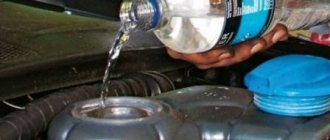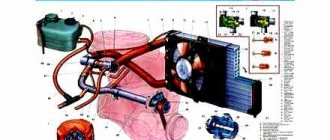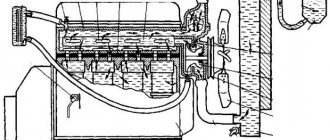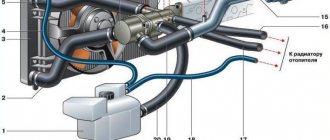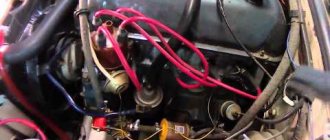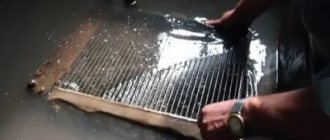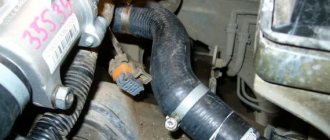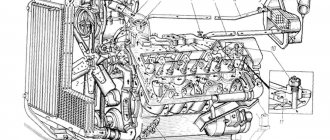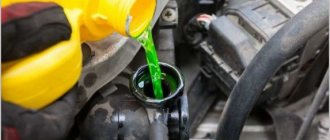Ways to solve the problem
In order not to experience discomfort from the cold inside the car in winter, it is necessary to properly maintain the cleanliness of the cooling system. This will require a lot of effort from the car enthusiast. The main problem in servicing this system is that there is no universal means for cleaning the cooling system from both decomposition products of old antifreeze and corrosion products.
Here we can clearly see two sides of the same coin: acid solutions can easily deal with corrosion products, but they are useless for antifreeze residues (alkali is needed here). As you know from a school chemistry course, combining such products in one composition reduces their effectiveness to zero, because alkali neutralizes acid. As a result of this, we get a completely ineffective remedy.
We can draw a simple conclusion: most commercially available specialized chemicals for cleaning a car’s cooling system will not cope with this task fully, so it is necessary to service it in a timely manner so that you do not have to deal with additional difficulties.
Available means
To flush the cooling system, industry today produces a number of chemical reagents. However, we all know that improvised means can often be much more effective. A separate advantage would be to note the cost-effectiveness of such maintenance methods. One of the main ways to prevent incorrect operation of the “stove” is to flush the engine cooling system with citric acid. Let's see why this method is so popular and how to use this affordable troubleshooter?
How can you tell if your cooling system needs flushing?
It is worth paying attention to the color of the coolant. The method depends on the design of the cooling system of your car. For example, on domestic VAZ cars, the reservoir is part of the circulation system - the fluid flows through it, and the condition of the fluid is easy to assess by removing the lid and looking inside.
ATTENTION!
All manipulations can only be carried out with a cooled engine. If you open an expansion tank with hot coolant, it may boil and splash out.
On foreign cars, the tank can be constructed as a separate element, through which there is no circulation. The expansion tank pipe comes out of the radiator filler neck. A certain level must be maintained in the tank. If the pressure in the system increases, excess liquid is sent through the pipe into the tank. If a vacuum is created, the system takes the missing volume of liquid from this tank.
In the second case, looking at the liquid in the tank may not give a complete picture of the condition of the cooling system. Therefore, it is necessary to drain a little coolant through the radiator fitting and check its quality.
Coolants are produced in three colors: blue antifreeze, antifreeze can be red, orange or green (less often blue, yellow). In any case, if the coolant has been changed regularly and the system is not seriously contaminated, you can visually determine what kind of liquid it is. If there is dirty liquid in the system, this is a clear signal to at least replace the coolant and flush the cooling system with water.
How to flush the engine cooling system with citric acid
The process seems complicated. However, we hasten to assure you that there is nothing critically difficult about it. It is enough to go through several stages of preparation:
- calculate the required mass of citric acid;
- prepare a working solution;
- prepare a container for draining antifreeze, rags and available materials in case you spill anything.
We will start by calculating the required volume. The most important component of the preparation when flushing the engine cooling system with citric acid is the proportion of the active substance. For a volume of 8 liters, about 150 grams of citric acid is needed. Standard sachets are usually available in 30 gram packs (we will need at least 5 sachets. More is better).
We recommend purchasing citric acid in advance, with a small supply.
How to flush the cooling system when changing the fluid?
If the check reveals that the coolant has an uncharacteristic color, or the engine begins to overheat in hot weather, then it is necessary to drain the old coolant and flush the system with water. You can find the volume of the machine's cooling system in the owner's manual or on the Internet. Usually this is about 7-8 liters for common engines with a volume of 1.5 - 1.6.
Flushing the system with water is simple: fill in the required flush volume, start the engine and wait for the thermostat to open. Let the engine idle for 10 minutes. After this, turn off and let cool. Then the water must be drained and, if possible, the system must be purged with a compressor. If the water is dirty, repeat the procedure.
At the end of the flushing, coolant is added. Every 100 kilometers you need to check its level, the absence of leaks at the joints of the system, and observe the color of the liquid. If it changes again, the system needs more serious flushing.
Procedure
First of all, you need to drain the antifreeze. To avoid wasting this valuable substance, we strongly recommend that you drain it carefully. To do this, you can use any convenient container: a bucket, an empty plastic bottle, etc. After removing the protective shield, unscrew the cap on the radiator, first replacing the container. Antifreeze can drain quite slowly, so be patient. To adjust the intensity, you can use the plug closing the expansion tank.
Then you can start working directly with our “magic” solution. After pouring diluted citric acid into the cooling system, add a little water according to the level. The following is what needs to be done:
- start the car, warm up the engine a little (to about 50 degrees);
- in neutral gear, increase the gas (up to approximately 3 thousand revolutions), let the engine run in this mode for some time (8-10 minutes is enough to warm up to 100 degrees);
During such warming up, a good “running” of the cooling system is ensured. After 10 minutes, turn off the engine and let it sit for a while. After a break, starting the car again, a sharp increase in engine temperature will be noticeable. This indicates that the liquid in the cooling system is no longer circulating. You should immediately turn off the engine and then carefully remove the throttle body hose. This will ensure free flow of gas.
Further interaction with the machine will be cyclical: warming up and removing the hose. After about an hour, you can safely drain the liquid (rinsing solution with citric acid), while rinsing the cooling system several times with plain water. 4-5 washes are enough to achieve a good result (the dark color of the water should completely disappear).
Car service frequency
It is recommended to perform cooling flushing at least once every two years. Also, the car owner should remember about the mandatory replacement of antifreeze, which can maintain its performance characteristics for 2 years or with a mileage of 50,000 kilometers.
Flushing the radiator and the entire cooling system must be performed in the following cases:
- Lumps of dirt and scale flakes appeared in the antifreeze.
- The antifreeze in the expansion tank has become cloudy and darkened.
- Frequent overheating of the engine is noted.
- There are problems with the thermostat.
- The fan on the radiator began to operate noticeably more often.
- There were problems with the operation of the interior heater.
It will also be interesting: What material to choose from for car mats
If the car owner ignores the need to flush the cooling, this leads to serious overheating of the engine, the cylinder head of which cracks, and subsequent repairs can be expensive. Therefore, it is necessary to regularly check the condition of the antifreeze and expansion tank, which will allow you to carry out the simplest service in a timely manner and avoid serious breakdowns of the power unit.
Advantages and disadvantages of the washing method
Of course, “folk” methods of repair and maintenance have both their supporters and opponents. Professional products for flushing the cooling system contain stronger acids, which naturally will have a positive effect on the quality of maintenance. But this is not always the case. A simple method of preparing a washing solution (such as diluting citric acid) significantly saves the car owner’s money, and the result may suffer minimally (or not at all). The choice is yours. It all depends solely on your desire and trust in the manufacturers of chemicals for car maintenance, as well as on the ability to incur regular expenses for expensive consumables.
Flushing the heater radiator. Where to begin?
In order to tackle such a complex and time-consuming process as flushing the heater radiator, it is best to first remove it from the car. However, this is not the easiest task. To flush the radiator with your own hands, you need to arm yourself with such simple things as a large 10-liter bucket filled with warm or hot water, a watering can, a mug and several bags of ordinary kitchen citric acid. The lemon juice must be poured into water and stirred until completely dissolved, then pour the resulting mixture directly into the radiator and leave for 15 minutes. This procedure should be repeated several times, draining the old water and pouring a new solution for the same period of time. The effect will be better if the water is as hot as possible. You can complete the procedure after the water coming out is almost clean.
Citric and acetic acid
Flushing the radiator with lemon juice and vinegar can thoroughly clean the dirt; however, after it, the device should be thoroughly washed with clean water, otherwise the remaining acid can lead to oxidative processes in the sealed areas over time. Having decided to clean the radiator at home, after washing it needs to be dried and ventilated. This procedure helps dry and remove large clumps of debris from the inside. Some owners use hydrochloric acid to clean the radiator of their own car, which remains in the device for almost 12 hours. The effect of such flushing will be immediately obvious; the radiator will acquire its original shine and will look like new.
Problem prevention
After completing the flushing, we recommend carefully monitoring the condition of the engine (in particular, the temperature). If noticeable heating occurs, it is necessary to immediately stop the vehicle, turn off the engine and carry out maintenance on the cooling system. Sudden temperature changes in most cases are due to the fact that the liquid inside the system does not circulate.
In extreme situations, contact a car service center for a comprehensive inspection and diagnosis of cooling system problems. Driving a car with high engine heating rates is extremely dangerous. It can lead to serious problems and the need for major repairs. Good luck on the roads!
